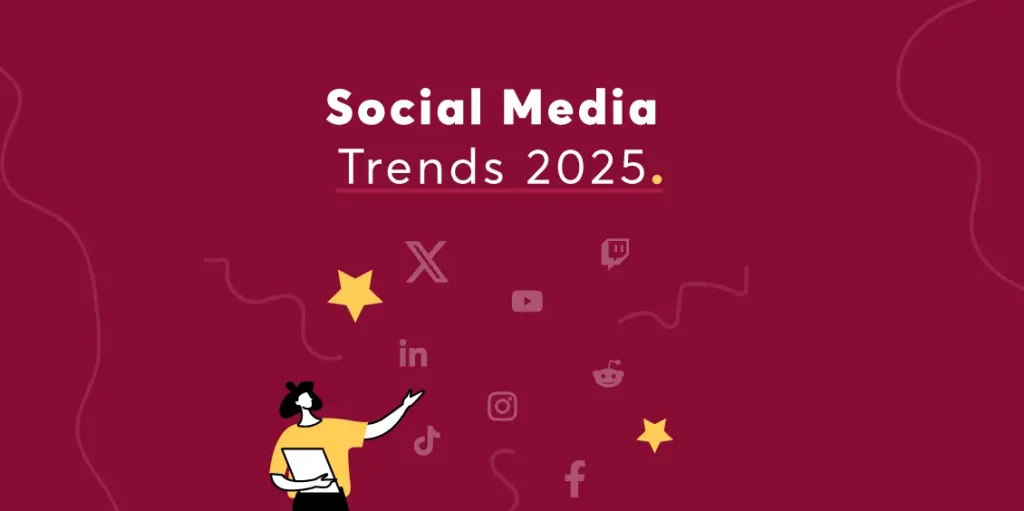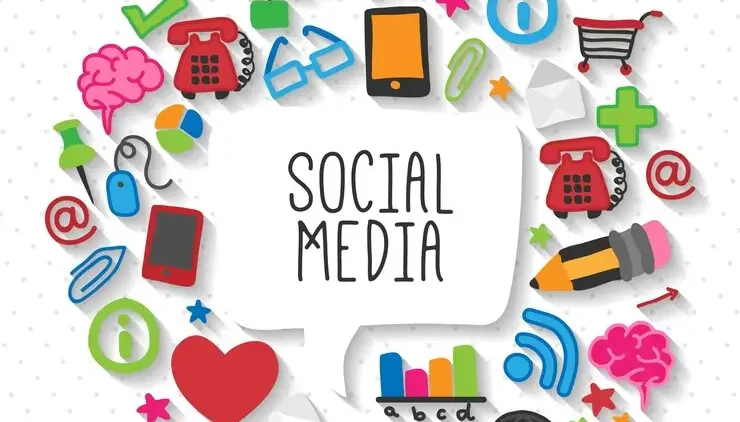Social Media Optimization Tips for 2025

Introduction: In 2025, social media has become an indispensable tool for brands, businesses, and individuals striving for visibility, engagement, and growth. With billions of active users across various platforms, standing out in this crowded digital space can be a daunting challenge. SMO (Social Media Optimization) Tips is the art of using social media platforms to build a brand, drive traffic, and create meaningful connections with your audience. But how do you optimize your social media presence for the best results? In this blog post, we’ll delve into practical, actionable, and 100% unique tips that can help you master social media optimization and get ahead in 2025. Whether you’re a marketer, business owner, influencer, or content creator, these strategies will enable you to enhance your social media efforts and see measurable improvements. 1. Know Your Audience Thoroughly: Before diving into any optimization techniques, it’s crucial to understand your audience. Knowing who you’re talking to will guide your content strategy, tone, and posting schedule. Use social media analytics tools to gain insights into your audience demographics, interests, behaviors, and engagement patterns. This helps you craft posts that resonate with your followers. For instance, platforms like Facebook and Instagram provide built-in audience analytics, while tools like Sprout Social and Google Analytics can help you understand your audience’s preferences across different channels. Once you know your target demographic, tailor your content to meet their needs and desires, increasing the chances of higher engagement. 2. Consistency is Key: Consistency isn’t just about posting regularly. It’s also about maintaining a consistent voice, visual style, and posting schedule across all platforms. A unified brand identity cultivates trust and enhances recognition with your audience. Therefore, it’s important to create a content calendar and stick to it. In addition to consistency in posting frequency, pay attention to the tone and message of your content. Whether your brand is formal, casual, playful, or authoritative, keep the tone aligned with your identity. Consistent messaging helps your audience to instantly recognize your posts, creating a sense of familiarity that leads to increased interaction. 3. Leverage Hashtags Wisely: Hashtags are one of the most effective tools for improving the discoverability of your social media content. But there’s a right way to use them, especially in 2025. Generic or overused hashtags won’t get you the results you need, so it’s important to focus on specific and niche hashtags that are relevant to your brand or industry. Research popular hashtags in your niche using tools like Hashtagify or RiteTag. Also, pay attention to trending hashtags related to current events, holidays, or popular movements, and incorporate them into your posts when appropriate. But always ensure that your hashtags are relevant to the content to avoid coming off as spammy. 4. Optimize Visual Content: In today’s visually driven world, the quality of your images, videos, and graphics can make or break your social media performance. Platforms like Instagram and TikTok are built around eye-catching visual content, and even on Twitter and LinkedIn, posts with images or videos tend to get more engagement than text-only posts. Ensure your visuals are high-quality, well-lit, and professionally designed. Use design tools like Canva or Adobe Spark to create visually appealing graphics that align with your brand. Always consider the dimensions and format requirements for each platform to ensure your content looks its best on any device. 5. Post at the Right Time: Timing is everything in social media marketing. Sharing content at times when your audience is most engaged can greatly boost its visibility. However, the optimal time to post can differ based on your industry, audience demographics, and the platform you’re using. Use social media analytics tools to determine when your followers are most engaged. Most platforms, including Facebook, Instagram, and Twitter, provide insights into the best times to post based on your audience’s activity. Tools like Hootsuite and Buffer also allow you to schedule posts at peak times, ensuring your content reaches the maximum number of people. 6. Engage with Your Audience: Social media is a two-way street. Simply posting content and hoping for results isn’t enough. To effectively enhance your presence, you must actively engage with your audience. Respond to feedback, interact with user-generated content, and take part in community discussions. The more you engage with your audience, the more likely they are to trust and support your brand. Additionally, social signals—such as likes, shares, and comments—play a role in social media algorithms, so engagement can improve the visibility of your content. 7. Use Analytics to Track Performance: To measure the effectiveness of your social media optimization efforts, you need to track your performance using analytics. Each platform offers its own set of analytics, allowing you to see how well your posts are performing in terms of reach, engagement, and conversions. For example, Instagram Insights, Facebook Analytics, and Twitter Analytics provide data on metrics such as impressions, reach, engagement rate, click-through rate (CTR), and follower growth. By monitoring these metrics, you can identify what works and what doesn’t, allowing you to fine-tune your strategy for better results. 8. Utilize Stories and Reels: Short-form video content is exploding in popularity, and platforms like Instagram, Facebook, and even LinkedIn now offer Stories and Reels to engage users in a more interactive way. Stories provide a more casual, behind-the-scenes look at your brand, while Reels offer a chance to share quick, entertaining, or informative videos. These features are prioritized in social media algorithms, meaning they’re more likely to be seen by your followers. Using Stories and Reels regularly can help you stay top-of-mind and boost engagement. Consider using these tools to promote new products, share customer testimonials, or showcase your brand’s personality. 9. Collaborate with Influencers and Brands: In 2025, influencer marketing continues to be a highly effective strategy for boosting brand visibility and credibility. However, it’s important to work with influencers who align with your values and target audience. Similarly, collaborating with other brands can help you tap into new audiences. Joint promotions, co-hosted events, and cross-promotions can increase
Social Media Audience Growth

Introduction: In today’s digital landscape, social media has emerged as one of the most powerful tools for connecting with audiences, building brand presence, and driving business growth. Whether you’re an influencer, small business owner, or part of a global corporation, building a strong social media audience is crucial for success. But, in an environment where millions of posts, videos, and images are shared daily, how do you ensure your voice stands out? The key to success is mastering the art of social media audience growth. In this post, we will explore strategies to help you grow your social media audience, engage with followers effectively, and turn your online presence into a thriving community. 1. Understand Your Audience: Before you begin your journey of audience growth, it’s vital to understand who your target audience is. Social media is not a “one-size-fits-all” platform; different groups of people are active on various social media platforms, and they engage with content in diverse ways. Start by gathering demographic data about your current followers and website visitors. Use analytics tools on platforms like Facebook, Instagram, and Twitter to identify trends such as: Understanding these key insights will allow you to create content tailored to your audience’s preferences, leading to better engagement and growth. 2. Consistent Content Creation: One of the best ways to grow your social media audience is by consistently posting high-quality content. Consistency plays a crucial role in achieving success on social media. If you’re constantly posting valuable content, your audience will know when to expect new posts, which increases the likelihood of interaction. Content creation should focus on the following principles: Value: Every post should offer something valuable. Whether it’s educational, entertaining, or inspiring, your audience should feel that their time is well spent when interacting with your content. Quality over Quantity: While posting frequently can be beneficial, never sacrifice quality for quantity. Concentrate on producing valuable content that deeply connects with your audience and drives meaningful engagement. Variety: Vary your content by sharing a blend of images, videos, polls, articles, and content created by your followers to maintain interest. This variety will keep your audience engaged and excited for more. Ensure that your content reflects your brand’s voice and values, as maintaining a consistent tone helps establish trust with your audience. 3. Leverage Visual Content: Humans are visual creatures. Studies show that people are more likely to engage with content that includes images or videos compared to text-only posts. Therefore, it’s essential to integrate visual elements into your social media strategy. Visual content can be anything from photos and infographics to short video clips or GIFs. Below are several strategies to effectively utilize visual content: Images: Share high-quality, eye-catching images that align with your brand’s aesthetic. High-quality photos can help draw attention as users scroll through their feeds. Videos: Video content continues to dominate social media, especially on platforms like TikTok, YouTube, and Instagram. Whether it’s a tutorial, behind-the-scenes footage, or a short-form video, videos have the potential to go viral and generate massive engagement. Infographics: Infographics are shareable and informative, making them an excellent option for educating your audience on complex topics. Using visual content will make your posts more engaging and increase the likelihood of attracting new followers. 4. Engage Actively with Your Followers: Building a social media audience growth is not just about posting content; it’s also about engaging with your audience. Social media is a two-way street, and fostering meaningful interactions with your followers is essential for growth. Here are some engagement strategies to consider: Respond to Comments and Messages: Engage with your audience by replying to their comments and direct messages. Acknowledging your followers’ comments fosters a sense of community and encourages more people to interact with your posts. Ask Questions: Encourage your followers to engage by asking questions in your posts or stories. This simple tactic helps spark conversation and increases engagement. Host Giveaways and Contests: Run contests or giveaways to create excitement and encourage participation. This can help you gain new followers while rewarding your existing audience. Use Polls and Quizzes: Interactive content such as polls and quizzes encourages followers to engage in a fun and easy way. Engaging with your audience builds loyalty, creates a sense of community, and helps increase your reach on social media. 5. Collaborate with Others: Collaborations are a great way to expand your social media audience quickly. When you partner with other influencers, brands, or creators in your niche, you tap into their audience base, which can result in increased exposure and new followers. There are several ways to collaborate effectively: Guest Posts: Share guest posts on each other’s profiles or blogs. This exposes both parties to new followers and encourages cross-promotion. Influencer Partnerships: Partnering with influencers who have a similar target audience can boost your credibility and bring in followers who trust their recommendations. Joint Live Sessions or Webinars: Collaborating on live sessions, webinars, or podcasts allows you to interact with your combined audience in real-time, building stronger relationships and expanding your reach. Always choose collaboration partners whose values align with yours and whose audience might be interested in your content. 6. Use Hashtags Wisely: Hashtags are a powerful way to increase the visibility of your content and attract new followers. They categorize your posts and help users discover content related to their interests. To use hashtags effectively: Use Relevant Hashtags: Avoid using generic or overly popular hashtags that are too broad. Focus on niche-specific hashtags that reflect the content you’re posting. Mix Popular and Niche Hashtags: Incorporating both popular and less competitive hashtags increases your chances of being discovered by a wider audience. Create Branded Hashtags: Creating a unique hashtag for your brand or campaign allows your followers to easily find and engage with your content. Remember, too many hashtags can look spammy, so try to strike a balance and limit your use. 7. Analyze and Adapt Your Strategy: As the digital landscape continuously changes, it’s essential to adapt your social media strategy accordingly. Regularly
Social Media Trends Guide 2025

Introduction: As we step into 2025, social media continues to be an integral part of our daily lives, influencing how we communicate, consume information, and engage with brands. The digital landscape is rapidly evolving, with emerging technologies, changing user behaviors, and new platform features reshaping how businesses and creators interact with audiences. To stay ahead of the curve, it’s crucial to understand the key social media trends guide that will dominate in 2025. This comprehensive guide explores the top trends, helping marketers, influencers, and businesses navigate the future of social media. 1. AI-Powered Content Creation and Curation: Artificial Intelligence (AI) is already transforming content creation, and by 2025, its impact will be even more pronounced. AI tools are increasingly being used to generate high-quality content with minimal human input. From writing blog posts and social media captions to creating videos and graphic designs, AI will automate and streamline content production processes. Tools like GPT-3 for text generation and DALL·E for image creation are just the beginning. By 2025, these technologies will be more advanced, enabling faster content creation with a higher degree of personalization. Additionally, AI-driven content curation will play a vital role in enhancing user experience. Social media platforms are already using AI to tailor feeds and recommendations based on individual preferences and behaviors. By 2025, AI will become even more sophisticated, offering hyper-personalized content that resonates deeply with users’ interests and emotional triggers. Businesses and creators can leverage AI to produce more relevant, engaging, and targeted content, helping them stand out in an overcrowded digital space. 2. The Rise of Immersive Experiences (AR/VR): Augmented Reality (AR) and Virtual Reality (VR) have already begun to take root in social media, but by 2025, these technologies will become mainstream, creating immersive digital experiences. AR filters on platforms like Instagram and Snapchat are just the beginning. In 2025, users will engage in more interactive and personalized experiences using AR, such as virtual try-ons for products, interactive gaming features, and AR-based live events. On the other hand, VR will allow users to immerse themselves in fully digital worlds. Social media platforms like Facebook (Meta) are already investing heavily in the metaverse, and by 2025, VR-based social networking could become a norm. Imagine attending a virtual concert, participating in live brand experiences, or connecting with friends in a virtual environment. As the hardware for AR and VR becomes more accessible and affordable, businesses and brands will need to incorporate these technologies into their marketing strategies to engage with younger, tech-savvy audiences. 3. The Evolution of Influencer Marketing: Influencer marketing has seen rapid growth over the past decade, but by 2025, it will evolve into something far more refined and authentic. The influencer landscape will no longer be dominated by mega-celebrities or influencers with millions of followers. Instead, micro and nano-influencers will take center stage, as consumers increasingly value authenticity and relatability. Additionally, influencers in 2025 will have to demonstrate more than just a large following. They will need to provide real value, whether through expertise, entertaining content, or engaging storytelling. Brands will seek influencers who align closely with their values and have a strong connection with their niche audiences. Trust, transparency, and ethical practices will become critical factors in choosing the right influencer for partnerships. Furthermore, the integration of AI and data analytics will allow brands to measure the effectiveness of influencer campaigns more accurately. By leveraging data, brands will be able to identify which influencers are driving meaningful engagement, leading to more effective collaborations. 4. Short-Form Video Dominates the Content Landscape: Short-form video content will continue to reign supreme in 2025. Platforms like TikTok, Instagram Reels, and YouTube Shorts have already established themselves as major players in the content ecosystem, and their dominance will only increase. The short-form video format is highly engaging, digestible, and ideal for the mobile-first generation that prefers quick, snackable content. In 2025, the power of short-form video will extend beyond entertainment. Educational content, product demonstrations, and behind-the-scenes glimpses will all thrive in short-form formats. Brands and businesses will need to invest in creative video strategies that capture attention in just a few seconds while delivering valuable messages. With social media platforms continually optimizing algorithms to prioritize video content, businesses will need to incorporate video marketing into their digital strategies to stay visible and relevant. 5. Privacy and Data Protection Take Center Stage: As concerns about data privacy continue to rise, social media platforms will face increasing pressure to implement stricter privacy measures. The implementation of more stringent privacy regulations will be a key trend in 2025. Following the European Union’s General Data Protection Regulation (GDPR) and similar initiatives globally, social platforms will be compelled to provide users with more control over their data. Additionally, the rise of decentralized platforms and blockchain technology will offer users more transparency and security in how their data is used. In 2025, users may begin to demand greater control over their personal information, and brands that respect this demand will build stronger trust and loyalty with their audiences. Marketers will also need to adapt their strategies to account for stricter privacy rules. Third-party cookies and cross-platform tracking may become a thing of the past, and businesses will have to rely more on first-party data and permission-based marketing to maintain effective audience engagement. Conclusion: The social media trends guide in 2025 presents unparalleled opportunities for innovation and growth. By understanding and adopting these trends, businesses can create impactful strategies that resonate with their audiences and achieve measurable success. Also Read: Social Media Audience Growth
How to Create Viral Social Posts

Introduction: In today’s digital landscape, social media is a powerful tool for businesses, influencers, and individuals to share content and engage with audiences. However, with millions of posts flooding social media every day, how create a viral post that captures attention and spreads like wildfire is a rare but highly coveted achievement. Whether you’re promoting a product, sharing personal content, or seeking to entertain, creating viral social media posts requires more than just posting randomly. In this blog post, we will walk you through proven techniques and best practices to help you craft social media content that has the potential to go viral. From creating eye-catching visuals to leveraging trending topics, here’s your complete guide to making posts that could gain massive engagement. 1. Know Your Audience: The first and most critical step in creating viral social media content is understanding your audience. You need to know what they like, what entertains them, what they’re struggling with, and what types of posts resonate with them. Demographics: Get to know the demographics of your audience, including their age, gender, location, and preferences. This helps you tailor your posts to be more relevant. Psychographics: Go beyond demographics by understanding the values, emotions, and beliefs of your audience. Engagement Patterns: Study when your audience is most active and which platforms they engage with the most. This can vary across different social networks. Once you have a firm grasp on these factors, you can create content that feels personalized and resonates with the audience, increasing the likelihood of your post going viral. 2. Create Visually Stunning Content: Eye-catching visuals have a higher chance of grabbing attention and being shared across social media platforms. Eye-catching images, videos, and infographics have a better chance of going viral than plain text-based content. Use the following visual elements to make your posts stand out: High-Quality Images & Graphics: Invest in quality visuals or use tools like Canva or Adobe Spark to create professional-looking graphics. Make sure the images are relevant to the message you’re trying to convey. Videos: Video content is incredibly shareable. Short-form videos, in particular, such as those on TikTok or Instagram Reels, tend to go viral due to their high engagement rate. Memes & GIFs: These humorous and relatable visuals are known for their viral nature. Creating meme-style content relevant to your audience can spark massive engagement. Consistent Branding: Make sure your visuals align with your brand colors and messaging. Consistency helps establish brand identity and can encourage more people to engage with your content. If you’re unsure what visual style will resonate with your audience, experiment with different types of content and track what works best. 3. Leverage Trending Topics and Hashtags: To maximize your post’s visibility, tap into trending topics or popular hashtags. These are hot conversations happening around specific events, cultural moments, or viral phenomena. By tying your content to something currently in the spotlight, you increase the likelihood of your post being discovered by a wider audience. Use Hashtags Wisely: Research trending hashtags and use them in your posts. Platforms like Twitter and Instagram heavily rely on hashtags for categorizing content. Make sure the hashtags are relevant to your post. Engage with Viral Challenges or Memes: Participating in viral challenges or memes can boost your chances of going viral. Create your unique take on a popular trend to stand out. Leverage News & Pop Culture: Posts related to current events or pop culture moments tend to grab attention. If there’s a significant news event that aligns with your brand, crafting a post that ties in can help you ride the wave of that viral conversation. Timing is crucial when leveraging trends, so make sure you act quickly and create content that fits seamlessly with the topic. 4. Craft Compelling, Shareable Copy: Your post’s message, or “copy,” plays a critical role in driving engagement. Crafting a message that resonates with your audience emotionally increases the chances of them sharing it. Here are some tips for writing share-worthy copy: Be Authentic: People are more likely to share content that feels genuine. Be yourself and avoid sounding overly salesy or scripted. Incorporate Emotions: Posts that evoke strong emotions (e.g., happiness, nostalgia, or empathy) are more likely to go viral. People love to share content that makes them feel something deeply. Include a Call to Action (CTA): Encourage your followers to like, comment, and share. A simple CTA like “Tag a friend who would love this!” can significantly increase engagement. Remember, people are more likely to share content that resonates with them or their social circles, so make your message relatable and shareable. 5. Experiment with Content Formats: Different formats tend to perform better on various platforms. You should experiment with multiple content types to figure out what works best for your audience. Some formats include: Polls and Questions: Interactive posts encourage people to engage directly with your content. Surveys, trivia, and open-ended questions are excellent tools for starting discussions and boosting interaction. Listicles or Guides: Educational content like “how-to” posts or lists can go viral, especially if they offer real value. People love to share useful, informative content. By experimenting with different formats, you increase your chances of finding something that resonates with your audience, driving engagement and potential virality. 6. Encourage User-Generated Content (UGC): User-generated content is one of the most powerful tools for building community and engagement. When your audience creates and shares content related to your brand, it increases authenticity and trust. Repost UGC: When followers tag your brand in posts, consider reposting their content (with credit). This not only rewards your audience but also shows that you value their engagement. Host a Hashtag Campaign: Create a branded hashtag and encourage users to share their content using it. For example, Coca-Cola’s #ShareACoke campaign was incredibly successful because it encouraged people to share personalized moments. Offer Incentives: Offering incentives like discounts or shoutouts for user-generated content can encourage more participation. UGC helps spread your content organically, giving it the potential to
Social Media for Beginners

Introduction: In the modern world, social media has evolved into a crucial aspect of everyday living. Whether you’re a teenager, a business professional, or someone who just wants to stay in touch with family and friends, social media platforms offer an exciting world of possibilities. If you’re new to social media, it can feel overwhelming to know where to begin. The good news is that social media is user-friendly and accessible to anyone willing to explore and learn. This blog post will guide you through the basics of social media, how to get started, and how to make the most out of your online experience. What is Social Media? Social media refers to platforms and websites that allow users to create, share, and interact with content. From posting status updates to sharing photos, videos, and thoughts, social media connects individuals across the globe, enabling communication and collaboration. Some of the most popular social media platforms today include Facebook, Instagram, Twitter, LinkedIn, YouTube, and TikTok. Each platform has its own unique features and ways of engaging with others, but they all serve the same purpose—connecting people. The major difference is the audience, types of content, and functionality they offer. For example, Instagram is known for its visual content, such as photos and short videos, while LinkedIn is tailored to professionals and job seekers. Why Use Social Media? Before diving into the specifics of how to use social media, let’s take a look at some of the key reasons why people choose to engage with these platforms. Staying Connected: One of the main benefits of social media is the ability to stay in touch with friends, family, and colleagues no matter where they are located. Whether it’s sharing life updates or simply chatting, social media makes communication instant and easy. Discovering New Content: Social media platforms are excellent tools for discovering new trends, news, and entertainment. You can follow your favorite celebrities, learn about breaking news, or dive into topics of interest. From DIY tips to travel inspiration, there’s something for everyone. Networking Opportunities: For professionals, social media is an invaluable tool for networking. Platforms like LinkedIn allow you to connect with colleagues, mentors, and potential employers. Social media can also help you grow your brand and create a personal or business presence online. Expressing Yourself: Social media provides a platform for individuals to express themselves creatively. Whether it’s through a personal blog, a photo gallery, or a video, you can use social media to showcase your talents, passions, and hobbies. Getting Started with Social Media Now that you understand what social media is and why it’s so popular, it’s time to explore how to get started. Step 1: Choose Your Platform: The first step is to decide which social media platform best suits your needs. Below are some of the most popular platforms and who they’re designed for: Facebook: Perfect for keeping connected with loved ones and close friends. It’s a versatile platform where you can share status updates, photos, videos, and join groups that align with your interests. Instagram: Known for its photo and video sharing capabilities, Instagram is perfect for creative individuals or businesses that want to showcase their lifestyle, products, or services. Twitter: A micro-blogging platform where you can share short posts (tweets) and follow others for real-time updates on a variety of topics such as news, entertainment, and sports. LinkedIn: The go-to platform for professional networking. LinkedIn helps you connect with industry professionals, share your resume, and find job opportunities. TikTok: A video-sharing platform that allows users to create short, engaging videos set to music. TikTok is particularly popular among younger audiences and those who enjoy making viral content. Step 2: Customize Your Profile: Your social media profile is like your online identity. It’s important to set it up in a way that reflects who you are or the brand you want to build. Here are a few suggestions for personalizing your profile: Profile Picture: Choose a clear and high-quality photo of yourself or your business logo. This image will represent you on the platform, so it’s important to make it visually appealing. Cover Photo: Many platforms, such as Facebook and LinkedIn, allow you to upload a cover photo. This image is displayed at the top of your profile and can be used to showcase your interests or personality. Bio: Write a short and compelling bio that tells people who you are and what you do. If you’re using the platform for professional purposes, be sure to include relevant information about your career or business. Privacy Settings: Social media platforms give you the ability to manage who has access to your posts. It’s a good idea to review your privacy settings and adjust them to ensure you’re comfortable with the level of access others have to your content. Step 3: Learn the Basics of Posting and Interaction: Once your profile is set up, it’s time to start engaging with others. Most social media platforms allow you to share content in various formats, including: Status Updates: Share your thoughts, updates, or news in a short post. This is usually text-based but can be combined with a photo, video, or link. Photos and Videos: Upload pictures or videos to showcase your life, business, or creative projects. Visual content is one of the most engaging types of content on social media. Comments: You can interact with other people’s posts by leaving comments. Engaging with others is a great way to build relationships and foster communication. Likes and Shares: These actions allow you to express your support for content. Liking a post shows appreciation, while sharing a post spreads it to your own followers. Step 4: Build a Network: One of the biggest advantages of social media is the ability to connect with people from all walks of life. As a beginner, you’ll want to build a network by following or friending other users. This will enable you to view their posts and engage with them. Follow/Connect with Friends and
Social Media Traffic Boosters

Introduction: In today’s digital age, driving traffic to your website is crucial for building a successful online presence. A highly impactful method to accomplish this is by utilizing social media networks. With billions of active users across platforms like Facebook, Instagram, Twitter, LinkedIn, and TikTok, leveraging social media to boost your website traffic is a smart strategy for any business or content creator. However, simply posting content on social media isn’t enough; you need a solid strategy to increase visibility and drive traffic. In this blog post, we’ll explore proven social media traffic boosters that can help you reach your target audience and increase website visits. 1. Create Shareable Content: One of the best ways to boost social media traffic is by creating content that is highly shareable. Shareable content encourages your audience to spread your message, which increases your reach and drives more traffic to your website. Shareable content comes in many forms, including: Infographics: These are highly visual, easy-to-digest, and perfect for social media. Infographics can quickly convey complex information and are often shared by users who want to provide value to their own followers. Videos: With the rise of video consumption, creating engaging video content that resonates with your audience can significantly boost traffic. Live streaming, tutorials, or behind-the-scenes content can increase engagement and encourage users to visit your website. Memes and Gifs: Humorous content like memes and gifs can go viral and increase visibility. While these are fun, ensure that they align with your brand’s voice and provide value. 2. Leverage Hashtags Effectively: Hashtags are a powerful tool on platforms like Instagram, Twitter, and TikTok. They assist in organizing content and enhancing its visibility to a broader audience. To use hashtags effectively: Use Relevant Hashtags: Do some research to find the most popular and relevant hashtags in your niche. Using generic or overly broad hashtags like #love or #followme won’t help your content get noticed by your target audience. Create Branded Hashtags: Developing your own unique hashtag can help build a community around your brand. Encourage followers to use your branded hashtag in their posts to increase visibility. Balance Popular and Niche Hashtags: Use a mix of highly popular and niche-specific hashtags to ensure your content gets seen by a diverse audience. 3. Post at the Right Time: The timing of your posts is crucial to their success on social media. Posting at the right time ensures that your content gets in front of your audience when they are most active. Here are a few tips: Know Your Audience: Identify the times when your target audience is most engaged. For instance, businesses targeting professionals might want to post during weekdays, while entertainment brands might find weekends more effective. Use Analytics: Most social media platforms offer analytics that can help you determine when your audience is online. Use these insights to schedule posts at the optimal times. 4. Engage with Your Audience: Engagement is a two-way street. If you want to boost traffic, you need to engage with your audience, not just post content and walk away. Here’s how you can increase engagement: Respond to Comments and Messages: Responding quickly to comments and direct messages demonstrates that you appreciate your audience’s feedback, helping to build a strong community and potentially driving more visitors to your website. Ask Questions and Run Polls: Encourage participation by asking questions or running polls. Encourage User-Generated Content: Invite your followers to create content related to your brand and share it on social media. User-generated content can be a powerful tool for driving traffic as it increases trust and authenticity. 5. Utilize Social Media Ads: If you want to give your website traffic a significant boost, social media advertising is an effective method. All major social media platforms offer targeted advertising options that allow you to reach a highly specific audience. Here’s how to make the most out of paid ads: Target the Right Audience: Social media platforms allow you to segment your audience based on demographics, interests, behaviors, and location. Use these targeting options to reach people who are most likely to be interested in your website. Create Compelling Ads: Ensure that your ads are visually appealing and have a clear call to action (CTA). A strong CTA should encourage users to visit your website. Experiment with Different Ad Types: Different platforms offer a variety of ad formats, such as carousel ads, video ads, and sponsored posts. Test out different ad formats to see which ones perform best. 6. Collaborate with Influencers: Influencer marketing has become a powerful tool for driving traffic to websites. Collaborating with influencers who have a large and engaged following in your niche can expose your website to a wider audience. Here’s how you can leverage influencer partnerships: Choose the Right Influencers: Find influencers whose values align with your brand and whose audience matches your target demographic. Create Engaging Campaigns: Work with influencers to create content that encourages their followers to visit your website. This could be through reviews, product demonstrations, or giveaways. Track Your Results: Use tracking links or affiliate programs to measure the success of your influencer campaigns and assess how much traffic they’re driving to your website. 7. Cross-Promote Across Multiple Platforms: Don’t limit your traffic-boosting efforts to just one social media platform. Cross-promoting your content across different platforms can significantly increase your reach. For example: Share your Instagram posts on Facebook: Share your Instagram posts on your Facebook page to connect with a new set of followers. Share blog content on Twitter: Post snippets or links to your blog posts on Twitter to direct followers to your website. Use TikTok and YouTube together: If you create short-form videos for TikTok, repurpose them for YouTube Shorts or Instagram Reels to increase exposure. 8. Run Contests and Giveaways: Running contests and giveaways is a great way to boost engagement and drive traffic. People love winning prizes, and if you require participants to visit your website as part of the entry process, you can significantly increase
Creative Social Media Ideas

Introduction: In today’s digital age, social media is a powerful tool for businesses, influencers, and individuals alike to connect, share, and engage with their audience. However, with the constant flow of content, it can be challenging to stand out and capture attention. That’s where creative social media ideas come into play. These ideas can help you engage your audience, increase brand awareness, and create a loyal following. Whether you are a small business, a large corporation, or an individual looking to boost your personal brand, the key to success on social media lies in creativity. Here are some fresh and innovative social media ideas to help you take your online presence to the next level. 1. Host Interactive Polls and Quizzes: Polls and quizzes are excellent tools to engage your audience and gather valuable insights. These interactive posts allow followers to share their opinions on different topics, such as product preferences, industry trends, or fun facts related to your brand. Polls and quizzes are easy to create on platforms like Instagram, Twitter, and Facebook, and they offer a great way to encourage participation and engagement. For example, if you’re a fashion brand, you could ask your followers to vote on their favorite season’s collection or participate in a quiz to find out their personal style. The results can be shared with your audience to further fuel conversations and discussions. By creating an interactive experience, you can increase your followers’ connection to your brand and show that you value their opinions. 2. Behind-the-Scenes Content: People love to get a glimpse of what happens behind the scenes. Sharing content that shows the process behind your products or services can humanize your brand and make your followers feel more connected. For businesses, this could mean showcasing how products are made, the creative process behind a photoshoot, or a look into the day-to-day activities of your team. For influencers or personal brands, behind-the-scenes content could include what a typical day looks like for you, how you create your content, or how you manage work-life balance. This type of content not only boosts authenticity but also helps your followers feel like they are part of your journey. 3. User-Generated Content: User-generated content (UGC) is one of the most powerful ways to build trust and foster community engagement on social media. Encouraging your followers to share their own experiences with your brand, whether it’s through photos, videos, or testimonials, gives your audience a voice and strengthens your brand’s authenticity. To encourage UGC, consider running contests or giveaways where followers are asked to create content related to your brand, such as using your product in unique ways or sharing a story about how your brand has impacted them. Make sure to credit the user when you share their content to show appreciation for their contribution. 4. Time-Limited Offers and Flash Sales: Scarcity and urgency are powerful psychological tools in marketing. Offering time-limited discounts or flash sales on social media creates a sense of urgency that can drive immediate action. Whether it’s a one-day sale or a flash offer for your followers, announcing these deals through creative social media posts can spur your audience to act quickly. To make these offers even more engaging, use countdown timers, GIFs, or videos to build anticipation. You can also create exclusive discount codes for your social media followers to make them feel special and encourage more people to follow your accounts for future deals. 5. Go Live with Q&A Sessions or Interviews: Live streaming is one of the most engaging and authentic ways to connect with your audience in real-time. Hosting live Q&A sessions or interviews with experts or influencers in your industry can create a sense of excitement and anticipation. Promote your live sessions ahead of time to let your followers know when to tune in, and encourage them to ask questions or participate in the conversation. Live content allows your audience to interact with you directly and can provide valuable insights into their interests and concerns. This type of content also helps to humanize your brand and foster a sense of connection. 6. Leverage Instagram and TikTok Stories: Instagram Stories and TikTok offer a creative space for short, ephemeral content that feels more authentic and casual compared to traditional posts. Both platforms allow you to share moments in real-time, giving your audience a behind-the-scenes look at your day-to-day life or business operations. Consider using Stories to share quick updates, new arrivals, product launches, or sneak peeks. You can also use interactive features like polls, question stickers, quizzes, or countdowns to encourage engagement. The fleeting nature of Stories also creates a sense of urgency, encouraging your followers to check in regularly for fresh content. 7. Create Educational and Value-Driven Content: People love to learn, and social media is a great place to share valuable knowledge with your audience. Consider creating educational posts, tutorials, how-to guides, or infographics that provide real value to your followers. If you’re a beauty brand, for example, you could create tutorials on how to achieve different makeup looks using your products. If you’re a fitness expert, you could share workout tips, nutrition advice, or wellness challenges. Educational content not only provides value but also positions you as an authority in your niche. Over time, this can help build trust and credibility with your audience. 8. Start a Challenge or Hashtag Campaign: Challenges and hashtag campaigns are a fun and engaging way to get your audience involved in a creative way. Starting a challenge that aligns with your brand or industry can encourage your followers to participate and share their own content. For example, a fitness brand could start a 30-day workout challenge, or a travel brand could launch a hashtag campaign where followers share their favorite vacation spots. By encouraging user participation, you create a sense of community around your brand and increase visibility as people share the challenge with their own networks. 9. Seasonal and Holiday-Themed Content: Capitalizing on holidays and seasonal events is
Social Media for Businesses

Introduction: In the modern digital landscape, social media has become a powerful tool for businesses, offering a range of opportunities to engage with customers, build brand awareness, and drive growth. Social media for businesses is no longer just a trend but an essential part of any comprehensive marketing strategy. From small startups to large corporations, companies across industries are recognizing the value of platforms like Facebook, Instagram, Twitter, LinkedIn, and TikTok to connect with their audiences, foster relationships, and achieve their business objectives. This blog post will explore the significance of social media for businesses, the benefits it offers, the best practices for leveraging social media platforms, and how to create an effective strategy. The Importance of Social Media for Businesses Social media is essential for businesses as it offers a direct and cost-effective way to connect with a global audience. It helps increase brand visibility, allowing companies to reach potential customers in ways traditional marketing can’t. Social media fosters real-time engagement, building trust and loyalty among customers. It also provides valuable insights into consumer behavior, helping businesses tailor their strategies. By driving traffic to websites and online stores, social media supports conversions and growth. Platforms like Facebook, Instagram, and LinkedIn allow for targeted advertising, optimizing marketing spend. In today’s digital world, social media is a vital tool for maintaining a competitive edge. Best Practices for Social Media Marketing Social media marketing has become a cornerstone of modern business strategies, offering a direct and cost-effective way to engage with customers, promote products, and build brand awareness. To stand out in the crowded digital landscape, businesses must follow key best practices that can maximize the effectiveness of their social media campaigns. Here are some of the most powerful strategies for successful social media marketing: 1. Define Clear Goals and Objectives: Before starting your social media marketing efforts, it’s crucial to establish clear, measurable objectives. Whether your aim is to boost brand recognition, increase website visits, generate new leads, or build customer loyalty, setting defined goals ensures focus and enables you to monitor progress. By setting SMART goals (Specific, Measurable, Achievable, Relevant, Time-bound), you can effectively measure your performance and refine your strategy based on the results. 2. Know Your Audience: At the heart of every effective social media strategy is a deep understanding of your target audience. To create content that resonates, take the time to research your audience’s demographics, interests, behaviors, and pain points. Platforms like Facebook Insights and Instagram Analytics provide valuable data about your followers that can inform your content and engagement strategies. Tailor your posts to speak directly to your audience’s needs and preferences to foster better engagement and stronger relationships. 3. Choose the Right Platforms: Each social media platform offers unique advantages, and their effectiveness varies based on your specific audience and objectives. For example, Instagram and TikTok are perfect for visually-driven content in industries like fashion, beauty, or food, while LinkedIn is ideal for B2B marketing and thought leadership. Instead of trying to be everywhere, focus on the platforms where your audience is most active and where your content can shine. 4. Create High-Quality, Engaging Content: When it comes to social media marketing, high-quality content is the key to success. Whether it’s educational blog posts, entertaining videos, or behind-the-scenes glimpses, high-quality content grabs the attention of your audience and encourages engagement. Keep your posts varied and include different content types, such as images, videos, infographics, polls, and stories, to maintain interest. Ensure your content is aligned with your brand voice, and always aim to add value—whether through entertainment, education, or inspiration. 5. Post Consistently: Maintaining consistency is crucial for keeping your brand visible and memorable to your audience. Create a social media calendar to plan and schedule your posts in advance, ensuring that you maintain a consistent presence. Consistent posting helps to build brand recognition, boosts engagement, and creates a predictable experience for your followers. Tools like Hootsuite, Buffer, and Sprout Social can help automate and schedule your content across multiple platforms, saving time while maintaining regularity. 6. Engage with Your Audience: Social media is not just about broadcasting your messages; it’s about building relationships and fostering two-way communication. Engage with your followers by responding to comments, messages, and mentions in a timely and friendly manner. Encourage conversations through polls, questions, and calls to action (CTAs). Show appreciation for user-generated content (UGC) and share customer testimonials or reviews to build trust. 7. Monitor and Analyze Performance: Use analytics tools to assess and track the effectiveness of your social media campaigns. Most platforms offer built-in analytics that provide insights into key performance indicators (KPIs) like engagement rate, reach, impressions, click-through rate, and conversions. Regularly review your metrics to understand what types of content are performing well and which strategies need improvement. Use this data to optimize future campaigns, experiment with new ideas, and ensure that your social media efforts align with your business goals. 8. Stay on Top of Trends: The digital world is constantly evolving, and staying on top of social media trends can help you stay relevant. Stay updated on new features, trends, and tools across platforms, and adjust your strategy to stay relevant and effective. Experiment with trending topics and content formats to see how they resonate with your audience, keeping your brand fresh and in line with the latest cultural conversations. 9. Use Paid Advertising Wisely: While organic reach on social media can be powerful, paid ads are a great way to expand your reach and target specific audiences. Platforms like Facebook, Instagram, and LinkedIn offer advanced targeting to customize ads based on demographics, interests, and behaviors. Start small with your ad budget, test different ad formats and continuously refine your strategy based on the results. Paid ads can complement your organic efforts and accelerate growth. 10. Leverage Influencer Marketing: Influencer marketing is an excellent way to expand your reach and build credibility. Partner with influencers whose audience aligns with your brand and who can authentically represent your products or services.
Effective Social Media Branding

Introduction: In today’s digital world, social media has emerged as a key platform for businesses, influencers, and individuals to establish and grow their brands. With billions of active users across various platforms, social media offers a unique opportunity to reach a global audience, engage with followers, and foster brand loyalty. However, in order to make the most out of social media, it’s important to approach it with a strategic mindset. Effective social media branding involves more than just posting occasional content – it’s about creating a cohesive, authentic presence that resonates with your target audience. In this blog post, we’ll explore what effective social media branding entails, why it’s important, and how to build a strong, memorable brand online. What is Social Media Branding? Social media branding refers to the use of platforms like Facebook, Instagram, Twitter, LinkedIn, TikTok, and others to build and establish a recognizable identity for a business or individual. It includes the visual elements (like logos, colors, fonts) and the messaging (tone of voice, style, values) that come together to create a consistent and authentic representation of the brand online. Effective social media branding helps differentiate your brand from competitors and ensures that your audience has a clear understanding of what your business or personality represents. It’s not just about having a logo or a catchy tagline – it’s about crafting a narrative and an image that connects with people emotionally, encouraging them to engage, trust, and ultimately buy from or support you. Why Social Media Branding is Important In today’s digital age, social media branding has become a critical element for businesses and individuals seeking to establish a strong presence online. With billions of active users across various platforms, social media offers an unparalleled opportunity to connect with audiences, build brand recognition, and foster loyalty. Effective social media branding helps differentiate your business, ensuring that your messaging and visual identity resonate with your target audience. It also boosts trust and engagement, which directly influences customer behavior and sales. By maintaining consistency in tone, design, and messaging, brands can create a memorable experience for followers. Ultimately, social media branding helps businesses drive conversions, build lasting relationships, and stay ahead of the competition. In this post, we’ll explore the key reasons why social media branding is essential for success. How to Build an Effective Social Media Brand Building a strong social media brand doesn’t happen overnight. It demands careful planning, consistency, and a focus on the finer details. Below is a step-by-step guide to help you begin: 1. Define Your Brand’s Core Values and Purpose: Before you can develop an effective social media branding strategy, you need to understand your brand’s core values, mission, and purpose. Ask yourself the following questions: What does your brand stand for?What are your goals and objectives?Who is your target audience? 2. Identify Your Target Audience: Knowing your audience is key to any branding effort. On social media, your messaging, visuals, and tone should speak directly to the needs, interests, and pain points of your target audience. Are you targeting millennials, Gen Z, or working professionals? What kinds of content capture their attention and prompt the most interaction? Create customer personas that outline the characteristics of your ideal audience. These personas will help you tailor your branding strategy to their preferences, ensuring your content feels relevant and authentic. 3. Create a Cohesive Visual Identity: Your visual identity is a major component of social media branding. This encompasses your logo, color scheme, typography, and overall visual style. The goal is to have a consistent visual style that reflects your brand and makes it easily recognizable. Logo: Your logo should be clean, easily recognizable, and adaptable to various sizes. Make sure it looks good in different sizes and across multiple platforms. Colors: Choose a color palette that aligns with the emotions and messages you want to convey. Colors can evoke specific feelings – for example, blue often represents trust, while yellow evokes happiness and energy. Fonts: Select fonts that complement your logo and overall design. Keep it consistent across all platforms. Photography and Graphics: Use high-quality images and graphics that align with your brand’s visual style. Whether you’re posting photos or creating custom illustrations, they should always feel cohesive and aligned with your identity. 4. Develop Your Brand Voice and Messaging: Your brand voice defines how you engage with your audience on social media. It should embody your brand’s character and remain consistent across every platform. Whether your tone is formal, casual, witty, or motivational, it’s essential that it resonates with your target audience and aligns with your brand’s values. When crafting your messaging, consider: Tone: Should your voice be friendly, authoritative, or humorous? Language: Are you using technical terms, or keeping it simple and conversational? Consistency: Ensure that your messaging is uniform across all platforms and aligns with your overall brand identity. 5. Craft Compelling Content: Content is the backbone of social media branding. To keep your audience engaged, you need to consistently create and share high-quality content. Some ideas include: Educational Content: Provide insightful content that tackles your audience’s challenges or offers solutions to their queries. Behind-the-Scenes: Give your followers a glimpse into the inner workings of your brand, whether it’s the people behind the company, production processes, or daily operations. User-Generated Content: Motivate your followers to create and share content connected to your brand, such as reviews, photos, or videos featuring your products. Video Content: Videos, particularly short-form content on platforms like TikTok or Instagram Reels, are highly engaging and can help boost your visibility. 6. Stay Consistent: Consistency is key in social media branding. It’s important to post regularly and maintain a uniform presence across all platforms. This includes keeping a consistent posting schedule, using the same brand voice and visuals, and maintaining a steady flow of content. Develop a content calendar to plan out your posts in advance, ensuring that you’re consistently engaging with your audience without overwhelming them with too much content. 7. Engage with Your Audience:
Social Media Tools 2024

Introduction: In the fast-evolving digital landscape, staying on top of trends and utilizing the right tools is crucial for businesses and content creators who rely on social media for growth and engagement. As we step into 2024, social media platforms continue to dominate the online world, with over 4.7 billion active users globally. To keep up with this ever-growing ecosystem, leveraging advanced social media tools 2024 has become more important than ever. Whether you’re managing a brand, a small business, or personal content, the right tools can help you automate tasks, analyze performance, enhance engagement, and ultimately grow your online presence. In this blog post, we’ll dive into the essential social media tools of 2024, their features, and how they can help you take your social media strategy to the next level. 1. Content Creation and Design Tools: Creating visually appealing content is essential for engaging your audience on social media. In 2024, tools are helping creators and businesses design graphics, videos, and animations to boost engagement and increase reach. Canva: Canva remains a popular design tool with an easy interface for creating professional designs like social media posts and presentations. The platform offers thousands of templates, drag-and-drop features, and a library of images and fonts for all users. Adobe Spark: Adobe Spark offers a suite of creative tools for graphic design, video editing, and web page creation. With a focus on speed and ease of use, it allows businesses to create short-form videos, social posts, and ads on the go. In 2024, Adobe Spark continues to be essential for those looking to produce content quickly while maintaining high quality. Lumen5: For businesses and content creators who focus on video content, Lumen5 is a must-have. It uses AI to help you transform text-based content into engaging video posts. In 2024, it remains a game-changer for those who want to increase their video content output without spending hours editing. Lumen5’s intuitive platform can generate videos for social platforms like Instagram, Facebook, and TikTok, helping you reach a wider audience. 2. Social Media Management Tools: Managing multiple social media accounts can quickly become overwhelming, especially when you’re handling content scheduling, engagement, and performance tracking. The following tools are designed to streamline these tasks, allowing for more efficient social media management. Hootsuite: Hootsuite is a favorite for businesses and creators to manage and schedule posts across multiple social media platforms. In 2024, Hootsuite leads in managing Facebook, Twitter, LinkedIn, Instagram, YouTube, and TikTok from one dashboard. With social listening, reporting, and analytics, Hootsuite helps businesses monitor conversations, track performance, and engage seamlessly. Buffer: Buffer is a popular social media tool for scheduling posts, analyzing results, and managing content across platforms. In 2024, Buffer’s simple interface and advanced analytics make it ideal for small businesses and marketers to track engagement. Sprout Social: Sprout Social continues to be a powerful platform for social media management in 2024. It helps brands and businesses schedule posts, track performance, and engage with followers all in one place. The standout feature of Sprout Social is its reporting capabilities, which allow users to track both engagement metrics and ROI. Its ability to generate in-depth reports ensures that businesses can refine their social media strategies based on solid data. 3. Social Media Analytics Tools: Understanding the impact of your social media efforts is vital for making data-driven decisions. Social media analytics tools are crucial for tracking performance, audience insights, and engagement metrics. Google Analytics: While Google Analytics is primarily known for web tracking, it also offers in-depth social media tracking features. Google Analytics helps measure social media campaign effectiveness by tracking website traffic from social platforms. The ability to see how social media traffic converts into actual website interactions is vital for assessing the success of your social media strategy. Socialbakers: Now known as Emplifi, Socialbakers is a leading social media analytics platform in 2024 that offers powerful tools for social media performance tracking. Emplifi analyzes social media performance on platforms like Facebook, Instagram, and Twitter, providing insights on audience behavior and content. Iconosquare: Specializing in Instagram and Facebook analytics, Iconosquare remains a popular choice in 2024 for social media professionals who want to track engagement, monitor follower growth, and assess content performance. Iconosquare provides detailed reports on key metrics, allowing businesses to tweak their strategies and grow their social presence. 4. Social Media Automation Tools: Automation tools save time and effort, allowing you to automate tasks like scheduling posts, responding to messages, and more. In 2024, automation tools are helping businesses scale their social media operations without sacrificing engagement. Zapier: Zapier continues to be a powerful tool in 2024 for automating workflows between different apps. For example, Zapier can automatically share your new blog post on social media or send a direct message on Twitter when someone follows you. This level of automation ensures that you can stay active on social media without having to manually manage each task. ManyChat: ManyChat is a chatbot platform that allows businesses to automate customer service, sales, and marketing on social platforms like Facebook Messenger and Instagram. In 2024, ManyChat remains a top choice for businesses improving customer service and lead generation through conversational automation. SocialBee: SocialBee provides social media scheduling and automation services for businesses looking to grow their social presence with minimal effort. It allows users to categorize their content, schedule it for posting at optimal times, and automatically recycle high-performing posts. In 2024, SocialBee remains a favorite among small businesses for managing content and increasing visibility without daily manual input. 5. Social Listening Tools: Understanding what people are saying about your brand and industry on social media is crucial for making informed decisions. Social listening tools help monitor and track online conversations, providing valuable insights into customer sentiment and trends. Brandwatch: Brandwatch is an advanced social listening tool that tracks mentions of your brand, competitors, and industry keywords across various platforms. It provides real-time data on social conversations, sentiment analysis, and influencer activity. For businesses looking to maintain a pulse
